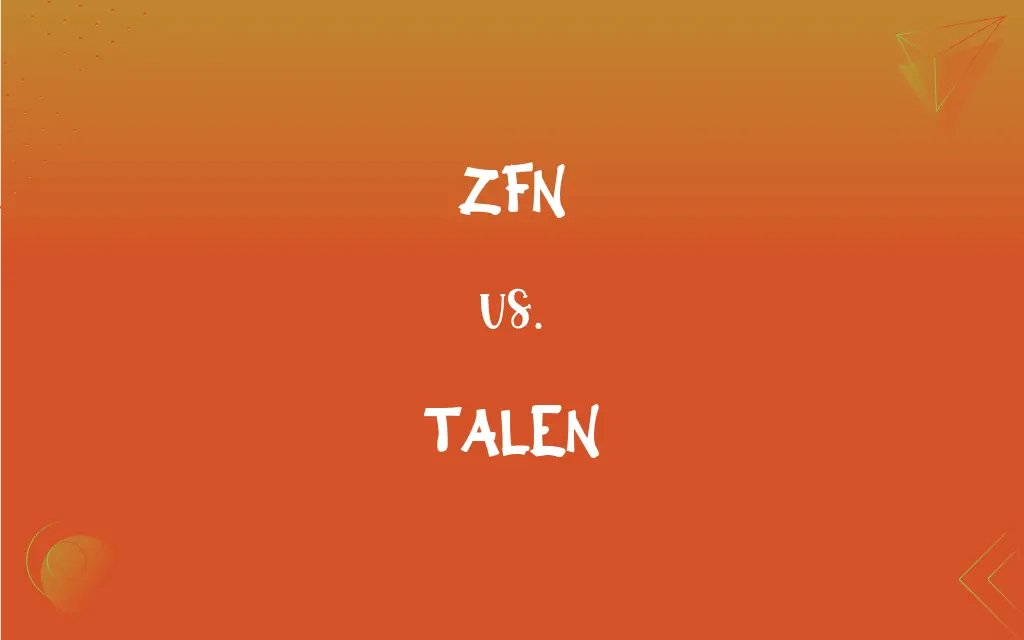ZFN vs. TALEN: What's the Difference?
Edited by Aimie Carlson || By Janet White || Published on February 5, 2024
ZFN and TALEN are both genome editing tools; ZFN uses zinc finger proteins for DNA binding, while TALEN uses transcription activator-like effector proteins.

Key Differences
Zinc Finger Nucleases (ZFNs) and Transcription Activator-Like Effector Nucleases (TALENs) are revolutionary genome editing technologies. ZFNs combine zinc finger DNA-binding domains with a DNA-cleavage domain, enabling targeted DNA modifications. TALENs, similarly, fuse TALE DNA-binding domains with a nuclease for precise genetic alterations. Both technologies have transformed genetic engineering by allowing specific gene targeting.
The construction of ZFN and TALEN differs significantly. ZFNs utilize a series of zinc finger domains, each recognizing a specific triplet of DNA bases. In contrast, TALENs are based on TALE proteins from Xanthomonas bacteria, where each domain recognizes a single base pair. This difference influences the specificity and ease of design for these genome-editing tools.
In terms of precision, ZFN and TALEN have unique characteristics. ZFNs, while powerful, can be challenging to design due to the complex interaction between adjacent zinc finger domains. TALENs offer a more straightforward design, as each TALE repeat corresponds to a single DNA base, allowing for more precise targeting.
Application scope of ZFN and TALEN also varies. ZFNs were among the first genome editing tools and have been used in a wide range of organisms. TALENs, emerging later, have quickly become popular due to their simplicity and high efficiency, expanding the possibilities in genetic research and therapy.
In terms of efficiency and off-target effects, both ZFN and TALEN present distinct profiles. ZFNs can suffer from off-target effects due to the overlapping nature of zinc finger binding. TALENs, with their one-to-one correspondence between DNA base and TALE repeat, typically exhibit fewer off-target mutations, making them a more precise tool in genome editing.
ADVERTISEMENT
Comparison Chart
Binding Mechanism
Uses zinc finger proteins
Uses TALE proteins
DNA Recognition
Recognizes specific triplets of bases
Recognizes single base pairs
Design Complexity
More complex due to zinc finger interactions
Simpler, one-to-one correspondence
Precision
Lower due to potential for off-target effects
Higher, fewer off-target effects
Historical Usage
Earlier development, broad application
Later development, quickly gained popularity
ADVERTISEMENT
ZFN and TALEN Definitions
ZFN
ZFN stands for Zinc Finger Nuclease, a type of engineered DNA-binding protein.
ZFNs have been instrumental in advancing gene therapy studies.
TALEN
TALENs consist of a TALE DNA-binding domain and a FokI nuclease domain.
TALENs enabled the targeted disruption of a disease-causing gene in human cells.
ZFN
ZFNs are composed of a DNA-cleavage domain and zinc finger proteins for DNA recognition.
The creation of a transgenic organism was achieved using ZFN-mediated genome editing.
TALEN
TALENs are customizable nucleases used for precise genetic modifications.
TALENs were utilized to introduce beneficial traits into crop genomes.
ZFN
ZFNs are genome editing tools combining zinc finger DNA-binding motifs with a nuclease.
The research team employed ZFN technology to correct a genetic mutation in cells.
TALEN
TALEN stands for Transcription Activator-Like Effector Nuclease, a tool for genome editing.
Researchers used TALEN technology to study gene function in zebrafish.
ZFN
ZFNs are biotechnological tools that facilitate targeted gene editing.
ZFNs enabled the precise alteration of a specific gene in a plant genome.
TALEN
TALENs offer a highly precise method for altering specific DNA sequences.
TALENs were applied to correct a genetic mutation in a patient-derived cell line.
ZFN
ZFNs are synthetic proteins that create double-strand breaks in DNA at specific locations.
Scientists used ZFNs to target and modify a gene in mouse embryos.
TALEN
TALENs are engineered proteins that create specific double-strand breaks in DNA.
The genetic modification in the lab mice was achieved using TALEN-based gene editing.
FAQs
What are ZFNs?
ZFNs are synthetic proteins used in genome editing to induce targeted DNA breaks.
What is TALEN?
TALEN is a genome editing tool that uses TALE proteins for DNA binding and a nuclease for cutting.
How do ZFNs recognize DNA?
ZFNs use zinc finger domains to recognize specific DNA triplets.
What is the main use of ZFNs?
ZFNs are mainly used for targeted gene editing and gene therapy.
What makes TALEN a preferred genome editing tool?
TALEN is preferred for its simplicity, precision, and lower off-target effects.
What is the role of the FokI domain in TALEN?
The FokI domain in TALEN is responsible for cutting the DNA strand.
Are ZFNs efficient in genome editing?
ZFNs are efficient but can have off-target effects due to complex zinc finger interactions.
How does TALEN differ from ZFN in DNA recognition?
TALEN recognizes single DNA base pairs, unlike ZFN's recognition of triplets.
Can TALEN be customized for any gene?
Yes, TALEN can be customized to target virtually any gene with high specificity.
Can ZFN and TALEN cause unintended mutations?
Yes, both can cause off-target mutations, but TALEN generally has fewer such effects.
Can ZFNs be used in human gene therapy?
Yes, ZFNs have been explored for use in human gene therapy with some success.
Is TALEN technology widely used in research?
Yes, TALEN is widely used in genetic research due to its precision and versatility.
Can TALENs be used in any organism?
TALENs are versatile and can be used in a wide range of organisms.
What are the advantages of TALEN over ZFN?
TALEN offers easier design, greater precision, and fewer off-target effects compared to ZFN.
What challenges are associated with using ZFN?
Design complexity and potential off-target effects are major challenges with ZFN use.
How do ZFN and TALEN induce DNA breaks?
Both ZFN and TALEN induce DNA breaks through a nuclease, leading to gene editing.
How is TALEN designed for a specific target?
TALEN is designed by customizing the TALE domain to bind to specific DNA sequences.
Are ZFNs suitable for complex genome editing?
ZFNs can be used for complex editing but require careful design to minimize off-target effects.
Can TALEN be used for therapeutic purposes?
TALEN has potential for therapeutic uses, especially in correcting genetic disorders.
What are the ethical considerations for using ZFN and TALEN?
Ethical considerations include potential unintended consequences and ethical implications of genome editing.
About Author
Written by
Janet WhiteJanet White has been an esteemed writer and blogger for Difference Wiki. Holding a Master's degree in Science and Medical Journalism from the prestigious Boston University, she has consistently demonstrated her expertise and passion for her field. When she's not immersed in her work, Janet relishes her time exercising, delving into a good book, and cherishing moments with friends and family.
Edited by
Aimie CarlsonAimie Carlson, holding a master's degree in English literature, is a fervent English language enthusiast. She lends her writing talents to Difference Wiki, a prominent website that specializes in comparisons, offering readers insightful analyses that both captivate and inform.
































































